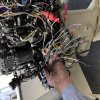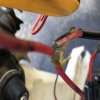- Joined
- Mar 28, 2015
- Messages
- 32
- Reaction score
- 0
- Points
- 0
- Age
- 61
- Location
- Yardley Pa
- Website
- www.t-c-pro.com
Can anyone points in the proper direction with what is going on with this motor?
Motor starts and runs for about 10 seconds then dies.
Start motor again and it runs for about 5 seconds and dies
Start motor again and it runs for about 3 seconds and dies
Try to start a fourth time and nothing
Fuel ball is not being sucked flat and pumping it slowly does nothing. Kill circuit disconnected and still does same. Checked ohm readings according to CDI and all within specs, took all 6 carbs off and thoroughly cleaned and rebuilt, swapped CDI power pack from other motor to this motor and same results, swapped key switch from one motor to other motor and same, have 110 psi +/- 2% across all cylinders, spark test jumps 7/16 gap.
Only thing we have not done is DVA test of stator as we are trying to locate someone who has a DVA meter we can use.
Could this be some sort of bad ground issue? We are perplexed because it seems like the motor is depleting something (fuel, spark, or a wire is heating up with each and every time we try to start) as evidenced by the way it tries to run shorter in duration each and everytime we try to start it.
Any ideas?
Motor starts and runs for about 10 seconds then dies.
Start motor again and it runs for about 5 seconds and dies
Start motor again and it runs for about 3 seconds and dies
Try to start a fourth time and nothing
Fuel ball is not being sucked flat and pumping it slowly does nothing. Kill circuit disconnected and still does same. Checked ohm readings according to CDI and all within specs, took all 6 carbs off and thoroughly cleaned and rebuilt, swapped CDI power pack from other motor to this motor and same results, swapped key switch from one motor to other motor and same, have 110 psi +/- 2% across all cylinders, spark test jumps 7/16 gap.
Only thing we have not done is DVA test of stator as we are trying to locate someone who has a DVA meter we can use.
Could this be some sort of bad ground issue? We are perplexed because it seems like the motor is depleting something (fuel, spark, or a wire is heating up with each and every time we try to start) as evidenced by the way it tries to run shorter in duration each and everytime we try to start it.
Any ideas?



